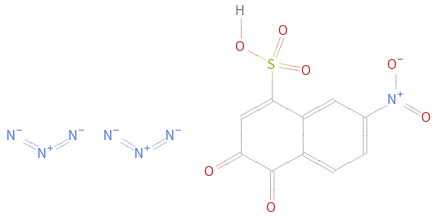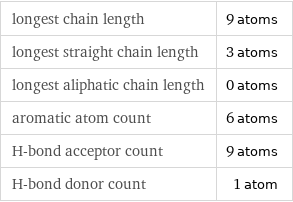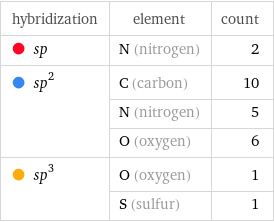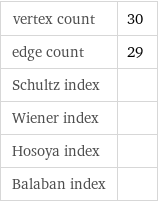Input interpretation

6-nitro-4-sulfo-2, 1-naphthoquinone diazide
Basic properties
[O-])C(=CC(=O)C2=O)S(=O)(=O)O.[N-]=[N+]=[N-].[N-]=[N+]=[N-] InChI identifier | InChI=1/C10H5NO7S.2N3/c12-8-4-9(19(16, 17)18)7-3-5(11(14)15)1-2-6(7)10(8)13;2*1-3-2/h1-4H, (H, 16, 17, 18);;/q;2*-1/f/h16H;; InChI key | IWUPHXJBBILNBE-UHFFFAOYSA-N](../image_source/987e195c41f93d797a4f818f0ae2b102.png)
molar mass | 367.3 g/mol formula | (C_10H_5N_7O_7S)^2- empirical formula | N_7O_7C_10S_H_5 SMILES identifier | C1=CC2=C(C=C1[N+](=O)[O-])C(=CC(=O)C2=O)S(=O)(=O)O.[N-]=[N+]=[N-].[N-]=[N+]=[N-] InChI identifier | InChI=1/C10H5NO7S.2N3/c12-8-4-9(19(16, 17)18)7-3-5(11(14)15)1-2-6(7)10(8)13;2*1-3-2/h1-4H, (H, 16, 17, 18);;/q;2*-1/f/h16H;; InChI key | IWUPHXJBBILNBE-UHFFFAOYSA-N
Structure diagram

Structure diagram
Quantitative molecular descriptors

longest chain length | 9 atoms longest straight chain length | 3 atoms longest aliphatic chain length | 0 atoms aromatic atom count | 6 atoms H-bond acceptor count | 9 atoms H-bond donor count | 1 atom
Elemental composition

Find the elemental composition for 6-nitro-4-sulfo-2, 1-naphthoquinone diazide in terms of the atom and mass percents: atom percent = N_i/N_atoms × 100% mass percent = (N_im_i)/m × 100% Plan: • Write the chemical formula and gather atomic masses from the periodic table. • Determine values for N_i, m_i, N_atoms and m using these items. • Finally, compute the percents and check the results. Write the chemical formula: (C_10H_5N_7O_7S)^2- Use the chemical formula to count the number of atoms, N_i, for each element and find the total number of atoms, N_atoms, per molecule: | number of atoms N (nitrogen) | 7 O (oxygen) | 7 C (carbon) | 10 S (sulfur) | 1 H (hydrogen) | 5 N_atoms = 7 + 7 + 10 + 1 + 5 = 30 Divide each N_i by N_atoms to calculate atom fractions. Then use the property that atom fractions must sum to one to check the work: | number of atoms | atom fraction N (nitrogen) | 7 | 7/30 O (oxygen) | 7 | 7/30 C (carbon) | 10 | 10/30 S (sulfur) | 1 | 1/30 H (hydrogen) | 5 | 5/30 Check: 7/30 + 7/30 + 10/30 + 1/30 + 5/30 = 1 Compute atom percents using the atom fractions: | number of atoms | atom percent N (nitrogen) | 7 | 7/30 × 100% = 23.3% O (oxygen) | 7 | 7/30 × 100% = 23.3% C (carbon) | 10 | 10/30 × 100% = 33.3% S (sulfur) | 1 | 1/30 × 100% = 3.33% H (hydrogen) | 5 | 5/30 × 100% = 16.7% Look up the atomic mass, m_i, in unified atomic mass units, u, for each element in the periodic table: | number of atoms | atom percent | atomic mass/u N (nitrogen) | 7 | 23.3% | 14.007 O (oxygen) | 7 | 23.3% | 15.999 C (carbon) | 10 | 33.3% | 12.011 S (sulfur) | 1 | 3.33% | 32.06 H (hydrogen) | 5 | 16.7% | 1.008 Multiply N_i by m_i to compute the mass for each element. Then sum those values to compute the molecular mass, m: | number of atoms | atom percent | atomic mass/u | mass/u N (nitrogen) | 7 | 23.3% | 14.007 | 7 × 14.007 = 98.049 O (oxygen) | 7 | 23.3% | 15.999 | 7 × 15.999 = 111.993 C (carbon) | 10 | 33.3% | 12.011 | 10 × 12.011 = 120.110 S (sulfur) | 1 | 3.33% | 32.06 | 1 × 32.06 = 32.06 H (hydrogen) | 5 | 16.7% | 1.008 | 5 × 1.008 = 5.040 m = 98.049 u + 111.993 u + 120.110 u + 32.06 u + 5.040 u = 367.252 u Divide the mass for each element by m to calculate mass fractions. Then use the property that mass fractions must sum to one to check the work: | number of atoms | atom percent | mass fraction N (nitrogen) | 7 | 23.3% | 98.049/367.252 O (oxygen) | 7 | 23.3% | 111.993/367.252 C (carbon) | 10 | 33.3% | 120.110/367.252 S (sulfur) | 1 | 3.33% | 32.06/367.252 H (hydrogen) | 5 | 16.7% | 5.040/367.252 Check: 98.049/367.252 + 111.993/367.252 + 120.110/367.252 + 32.06/367.252 + 5.040/367.252 = 1 Compute mass percents using the mass fractions: Answer: | | | number of atoms | atom percent | mass percent N (nitrogen) | 7 | 23.3% | 98.049/367.252 × 100% = 26.70% O (oxygen) | 7 | 23.3% | 111.993/367.252 × 100% = 30.49% C (carbon) | 10 | 33.3% | 120.110/367.252 × 100% = 32.71% S (sulfur) | 1 | 3.33% | 32.06/367.252 × 100% = 8.730% H (hydrogen) | 5 | 16.7% | 5.040/367.252 × 100% = 1.372%
Elemental oxidation states

The first step in finding the oxidation states (or oxidation numbers) in 6-nitro-4-sulfo-2, 1-naphthoquinone diazide is to draw the structure diagram. Next set every oxidation number equal to the atom's formal charge: In 6-nitro-4-sulfo-2, 1-naphthoquinone diazide hydrogen is not bonded to a metal with lower electronegativity, so it will have an oxidation state of +1. Any element bonded to hydrogen gains the bonding electrons, decreasing their oxidation state by 1 for every bond: With hydrogen out of the way, look at the remaining bonds. There are 1 carbon-nitrogen bond, 2 carbon-oxygen bonds, 1 carbon-sulfur bond, 2 nitrogen-oxygen bonds, 3 oxygen-sulfur bonds, 11 carbon-carbon bonds, and 4 nitrogen-nitrogen bonds. For each of these bonds, assign the bonding electrons to the most electronegative element. First examine the carbon-nitrogen bond: element | electronegativity (Pauling scale) | C | 2.55 | N | 3.04 | | | Since nitrogen is more electronegative than carbon, the electrons in this bond will go to nitrogen. Decrease the oxidation number for nitrogen (by 1 for single bonds, 2 for double bonds, and 3 for triple bonds), and increase the oxidation number for carbon accordingly: Next look at the carbon-oxygen bonds: element | electronegativity (Pauling scale) | C | 2.55 | O | 3.44 | | | Since oxygen is more electronegative than carbon, the electrons in these bonds will go to oxygen: Next look at the carbon-sulfur bond: element | electronegativity (Pauling scale) | C | 2.55 | S | 2.58 | | | Since sulfur is more electronegative than carbon, the electrons in this bond will go to sulfur: Next look at the nitrogen-oxygen bonds: element | electronegativity (Pauling scale) | N | 3.04 | O | 3.44 | | | Since oxygen is more electronegative than nitrogen, the electrons in these bonds will go to oxygen: Next look at the oxygen-sulfur bonds: element | electronegativity (Pauling scale) | O | 3.44 | S | 2.58 | | | Since oxygen is more electronegative than sulfur, the electrons in these bonds will go to oxygen: Next look at the carbon-carbon bonds: element | electronegativity (Pauling scale) | C | 2.55 | C | 2.55 | | | Since these elements are the same the bonding electrons are shared equally, and there is no change to the oxidation states: Next look at the nitrogen-nitrogen bonds: element | electronegativity (Pauling scale) | N | 3.04 | N | 3.04 | | | Since these elements are the same the bonding electrons are shared equally, and there is no change to the oxidation states: Now summarize the results: Answer: | | oxidation state | element | count -2 | O (oxygen) | 7 -1 | C (carbon) | 4 | N (nitrogen) | 4 0 | C (carbon) | 2 +1 | C (carbon) | 2 | H (hydrogen) | 5 | N (nitrogen) | 2 +2 | C (carbon) | 2 +3 | N (nitrogen) | 1 +4 | S (sulfur) | 1
Orbital hybridization

hybridization | element | count sp | N (nitrogen) | 2 sp^2 | C (carbon) | 10 | N (nitrogen) | 5 | O (oxygen) | 6 sp^3 | O (oxygen) | 1 | S (sulfur) | 1
Structure diagram

Orbital hybridization Structure diagram
Topological indices

vertex count | 30 edge count | 29 Schultz index | Wiener index | Hosoya index | Balaban index |